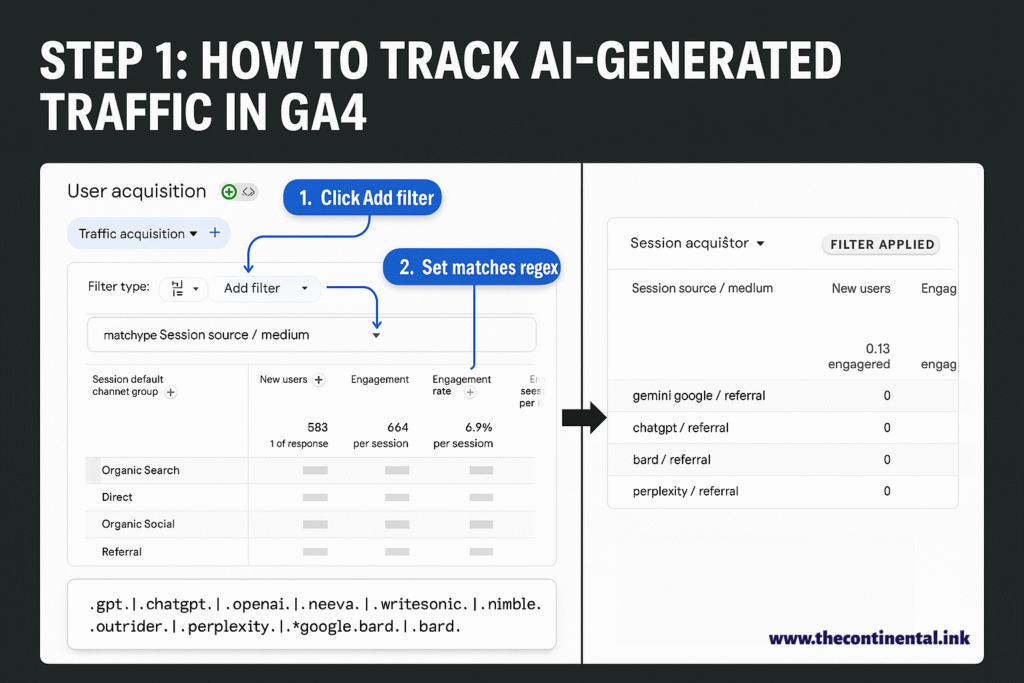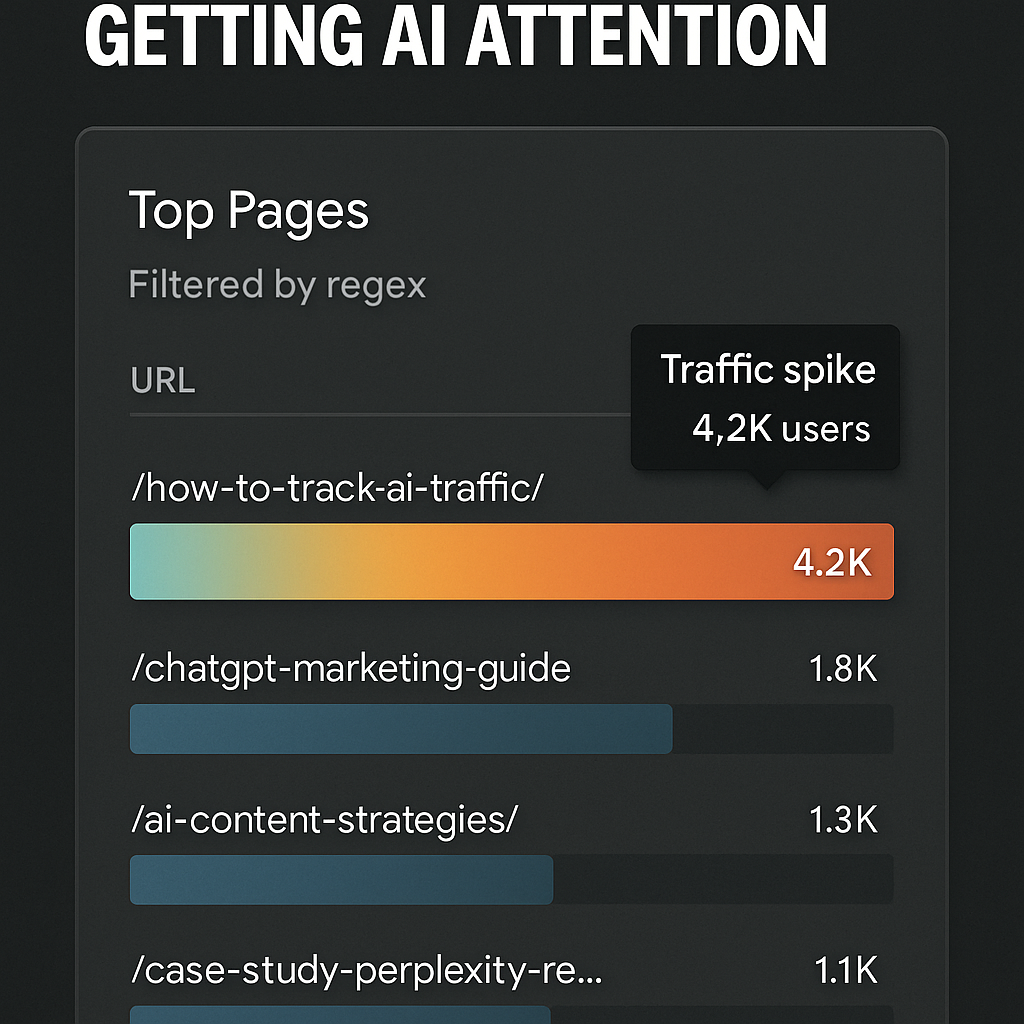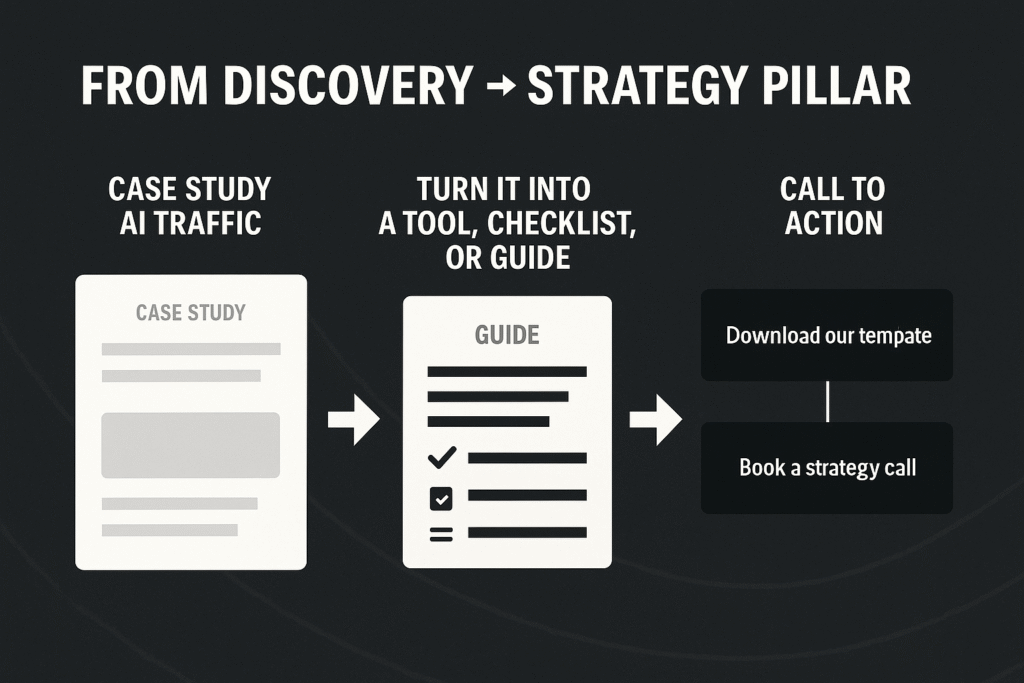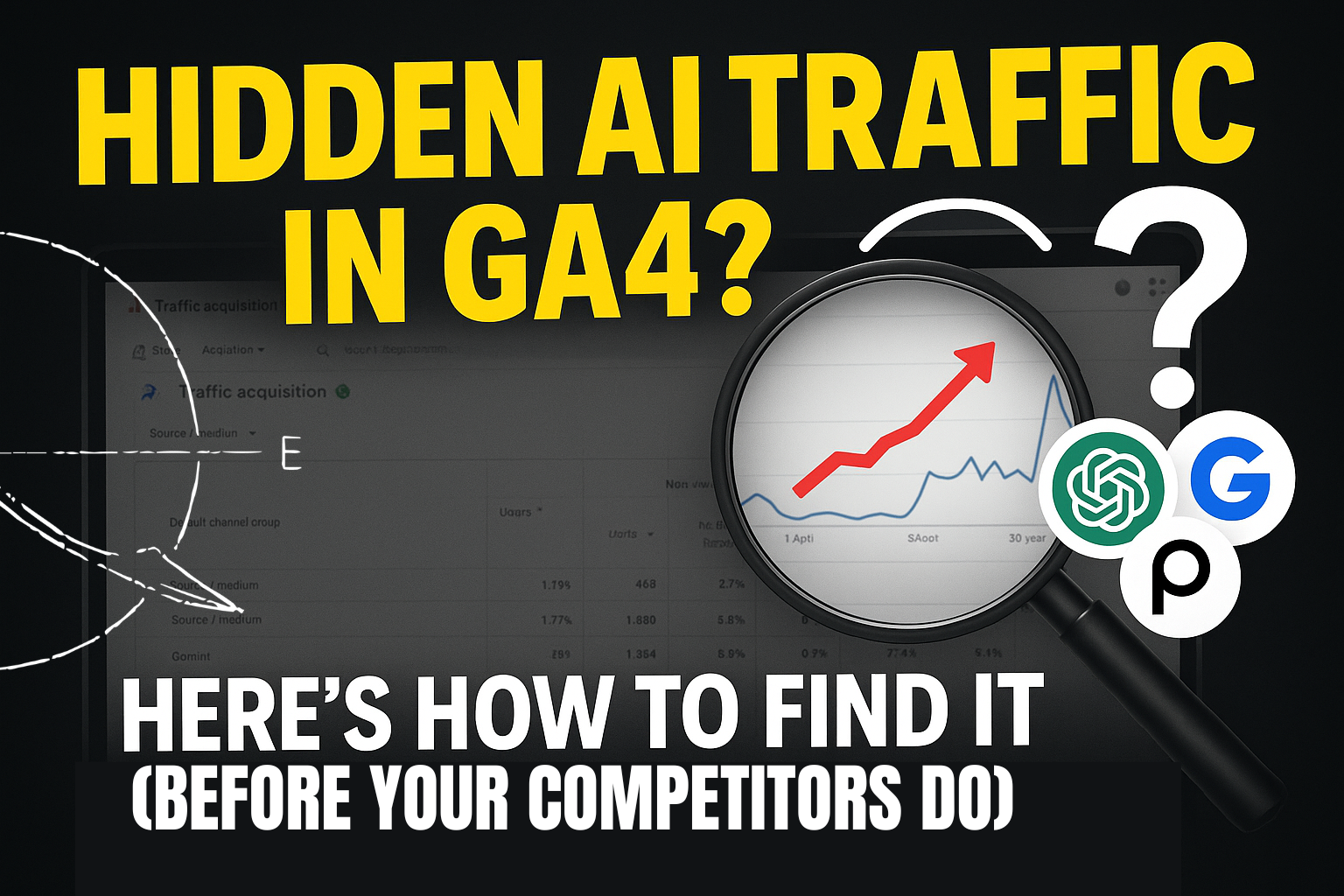AI is now shaping how people find and trust content online and it’s already influencing traffic, even if Google isn’t involved.
Tools like ChatGPT, Gemini, Perplexity, and Neeva are quietly referring visitors to websites through citations and source links, acting more like discovery engines than assistants.
This shift is happening behind the scenes, and while most marketers are still chasing search rankings, valuable AI-driven traffic is going unnoticed and unoptimized.
This post breaks down exactly how to find that hidden AI traffic, analyze what’s working, and build a strategy around it so that momentum turns into measurable growth.
The problem? Most marketers aren’t tracking this. And even fewer are building strategies to capitalize on it.
Let’s change that.
Step 1: How to Track AI-Generated Traffic in GA4 (In Under 2 Minutes)

Most marketers have no idea AI tools are already driving real traffic to their site—and it’s not showing up in typical dashboards.
Here’s how to surface it in Google Analytics 4 using a simple regex filter (no plugins, devs, or hacks required):
- Open GA4 and go to: Reports > Acquisition > Traffic acquisition
- In the top menu, click “Add filter”
- Under “Dimension”, choose: Session source/medium
- Set match type to: “matches regex”
- Paste this:
(.gpt.|.chatgpt.|.openai.|.neeva.|.writesonic.|.nimble.|.outrider.|.perplexity.|.*google.bard.|.bard.|.edgeservices.|.*gemini.google.)
This regex flags traffic referred from major AI engines, including ChatGPT, Gemini, Perplexity, Neeva, and others that embed or reference source links.
Once applied, you’ll see which of these tools are sending sessions to your site—and how much.
Bonus Insight: See Which Pages Are Getting AI Attention

Knowing where the traffic is going is just as important as knowing it’s coming.
To identify your top-performing pages from AI referrals:
- Go to Engagement > Pages and screens
- Apply the same regex filter to this report
This reveals the exact content that AI platforms are surfacing—and gives you a clear path for what to double down on.
Think of it as a cheat code to understanding what content AI thinks is most helpful, relevant, or authoritative.
Step 2: Reverse-Engineer Why Certain Pages Are Ranking in AI Responses
| Bad Content | AI-Friendly Content |
|---|---|
|
Vague headline Unclear topic or benefit |
Clear question Answers what users are asking |
|
Dense paragraphs Hard to scan or skim |
List / checklist format Quick to read and structured |
|
Generic framework No unique value |
Custom framework or tool Named, reusable, useful |
|
No POV or insight Feels templated or bland |
Original quote or data point Personal, opinionated, real |
|
Bare download link No setup or explanation |
Downloadable asset with context Linked within a helpful explanation |
Once you know which pages AI platforms are surfacing, the next step is critical:
Figure out why.
AI engines like ChatGPT and Perplexity don’t choose content at random—they reference content that fits specific formats, tones, and information structures. Reverse-engineering these pages helps you identify what’s working so you can build more of it.
Here’s how to break it down—with real examples and specific elements to look for:
1. Is the content answering a clear question?
AI tools love content that mimics the Q&A format.
Instead of:
“How to grow an email list” (as a vague blog post title)
Use:
“How to Grow an Email List from 0 to 1,000 Subscribers (Step-by-Step)”
Better yet, use subheadings like:
- "What is the best lead magnet for list building?"
- "How long does it take to build an email list from scratch?"
- "List-building mistakes to avoid"
AI engines scrape for this kind of clarity—it mirrors the exact type of query a user might ask.
2. Is the content structured for skimmability and scan-readers?
Think like an AI crawler. If your content is buried in dense paragraphs, it gets skipped.
But if it’s structured like this…
Use:
- Bullet points
- Numbered lists
- Clear subheadings
- Bold or italicized key takeaways
- Short paragraphs (1–3 lines max)
Example formats that tend to perform well:
- 5 Tools We Use for [X] and Why
- 7-Step Process to [Outcome]
- The Ultimate Checklist for [Topic]
- Before/After Comparison Tables
AI wants fast, bite-sized clarity. Give it the structure to reference and cite.
3. Does the content include a framework, methodology, or tool?
Pages that offer original systems or tools tend to get surfaced more because they appear authoritative and differentiated.
Examples:
- The ICE Framework for Prioritizing Growth Experiments
- Our AI Content Sprint Template
- The 3-Tier SEO Pyramid (Used to Rank 200+ Client Pages)
- Free ROI Calculator for B2B Funnels
If you name or define a process, AI is more likely to cite it—especially if it solves a common problem clearly.
4. Is the content human, opinionated, and helpful?
AI engines tend to down-rank vague, generic content.
Strong pages often include:
- Personal POVs or examples: “Here’s what worked for us”
- Contrarian angles: “Why we stopped sending weekly newsletters (and tripled open rates)”
- Real data or case studies
- Screenshots, templates, or tool links
- “We tried it, here’s what happened” style content
The more practically useful and unique your content is, the better it performs in AI answers.
5. Does it include embedded assets or reference links?
Perplexity and Gemini are especially likely to cite content that links to:
- Original research
- Visuals or diagrams
- Downloadable tools (e.g., Notion templates, Google Sheets)
- Clear internal links to related posts
Tip: Create a “Resources” block at the end of each article with links to other posts, tools, or downloads.
Step 3: How to Optimize Your Content for AI Discovery (Not Just Google)
Most content is still written to satisfy Google’s outdated checklist: meta tags, keyword density, backlinks, and all.
But AI platforms like ChatGPT, Perplexity, and Gemini don’t rank content.
They surface it based on how clearly it solves problems, how well it’s structured, and how useful it is to users.
To increase the odds your content gets cited or linked in AI-generated responses, here’s how to optimize for AI-first discovery:
1. Use Natural Language That Mirrors How People Ask
AI tools favor conversational, long-tail queries (the kind real people actually type or say).
Use subheadings like:
- How do I build a landing page that converts?
- What’s the best AI tool for writing sales copy?
- Step-by-step guide to launching a lead magnet
Avoid stiff, SEO-stuffed titles like: “Landing Page Optimization Lead Generation Guide 2025”
AI engines scan for clarity, not keyword soup. Make your content sound like an answer to a real question.
2. Include Direct Answers, TL;DRs, and Clear Definitions
AI models need fast, scannable content blocks they can cite or summarize.
Add:
- “In short…” summaries
- TL;DR blocks at the top or bottom
- Definitions inside boxes or italics:
“A nurture sequence is a series of automated emails that builds trust before a sale.”
Pro Tip: Use schema markup (e.g., FAQ or HowTo) to make this content even easier for AI tools—and Google—to parse.
3. Tie Content to Use Cases and Outcomes
AI tools prefer pages that help users do something, not just learn about something.
Compare:
- “What is email segmentation?” (vague, passive)
- “How to Segment Your Email List to Increase Open Rates” (action-oriented, goal-driven)
Embed:
- Use case callouts (“Use this if you sell high-ticket services”)
- Templates or calculators
- Before/after examples
- Screenshots of the method in action
Content with intent + implementation = AI-worthy.
4. Strengthen Internal Linking and Site Structure
AI models prioritize context-rich, well-connected pages. Pages that live in isolation tend to get ignored.
Best practices:
- Add 3–5 internal links per blog post
- Create pillar pages with clear content clusters
- Link to key assets (lead magnets, tools, frameworks) naturally
Use anchor text that clearly reflects the destination topic.
“See our full nurture email guide” → not “click here.”
Bonus Tip: Build a dedicated “Resource Library” or “Start Here” page to funnel AI tools into your content ecosystem.
5. Share Original Thought, POVs, and Contrarian Takes
Don’t be afraid to plant a flag.
AI platforms increasingly surface unique, quotable insight (especially from personal experience or expert opinion).
You can:
- Share what didn’t work and why
- Present frameworks in your voice (e.g., “The Content Ladder Strategy”)
- Take a stance: “We stopped sending newsletters and conversions went up 3x”
AI wants to pull content that stands out. If you sound like everyone else, you’ll blend into the background.

Step 4: So You’ve Got AI Traffic… Now What?
This is the part where things get interesting.
Let’s say you check your GA4 reports and spot a spike from ChatGPT or Perplexity. Maybe it’s all landing on a blog post you published six months ago and kind of forgot about. Or maybe it’s hitting a tools page you didn’t even realize was that useful.
That’s a signal.
It means the AI gods have found something they like. And now, you’ve got a choice: treat it like a lucky blip… or build on it.
Let’s talk about building on it.

First, figure out why it’s working
Don’t just note what page is getting traffic. Pause for a minute and dig into why that page.
Is it giving a clear answer to a question?
Is it neatly structured—like a checklist or a step-by-step tutorial?
Is it connected to a tool, a download, maybe a framework you casually named and forgot about?
You’re looking for patterns here. Not just topics, but the shape of the content. That’s what AI tools tend to favor.
If it’s a checklist, that’s your clue.
If it’s a case study, maybe it’s the story-driven format that’s working.
Sometimes it’s just how ridiculously specific you were.
Then—lean into it, just a bit
Here’s where most people get it wrong: they try to scale too fast or too wide. Instead, try this:
- Create a related piece. Something narrower, deeper, or slightly adjacent.
- Take the same format and apply it to a different use case or audience segment.
- Link those pieces together. AI tools love context—and so do real readers.
Think of it like building a small web of helpfulness around the original post. It doesn’t need to be a massive content campaign. Just enough to show depth.
Don’t forget to catch the leads
One thing we see a lot: content getting great AI traffic but doing nothing with it.
If the page has no call-to-action, no lead magnet, no soft invitation to take the next step… that’s a leak.
And no, it doesn’t need to scream BUY NOW. Something as simple as:
“Want to apply this to your business? Download our checklist.” or: “Need help with this? Book a quick strategy consult.”
Even a nudge is better than nothing. Especially when the reader didn’t come from Google—they came mid-question, via AI, looking for a shortcut.
Give them one.
Oh—and if it’s working here, it can probably work elsewhere
This part’s optional, but worth considering.
If AI tools like a page, there’s a good chance your LinkedIn followers, your email list, or even YouTube viewers will too. So repurpose it. Tweak it. Tell the same story in a different way.
Take that blog post and turn it into a carousel.
Or a walkthrough video.
Or a 2-minute email with a “Hey, this surprised me…”
You’re not reinventing the wheel here. Just giving the same message a few more chances to land.
All of this: AI traffic, citations, formats that work, it’s information.
But it’s also momentum. And if you don’t act on it, someone else will.
That page you didn’t think much of?
It’s probably your next strategy pillar. You just haven’t built around it yet.
Step 5: What Most Marketers Are Going to Miss
This whole AI-first discovery thing?
It’s still flying under the radar.
Most marketing teams are buried in spreadsheets and keyword tools, tracking the same metrics they’ve been watching for the last 10 years. Clicks. Rankings. Search volume.
Maybe some backlink velocity if they’re getting fancy.
Meanwhile, something quieter—but far more interesting—is happening.
AI platforms are starting to shape how people discover information, make decisions, and even choose who to buy from. Not in a flashy “this will replace Google overnight” way.
Just… subtly. In the background. One citation at a time.
And most marketers? They won’t see it coming until it’s too late.
So who does win in this shift?
Not the ones chasing hacks.
Not the ones building skyscraper content for algorithms that no longer matter.
And not the ones measuring performance solely by keyword position.
The ones who win are the ones who:
- Pay attention to what’s actually getting surfaced (Not what’s ranking—what’s referenced, linked, and cited)
- Adapt faster than they overthink (Maybe it’s not perfect, maybe it’s not optimized… but it’s useful, clear, and real)
- Create content that answers real questions (In a way that’s easy for both humans and machines to understand)
This isn’t about gaming AI. It’s about meeting the moment—showing up where trust is being built, one query at a time.
The old rules aren’t gone yet, but the game is changing.
And the people who notice now will have a head start later.
The others?
They’ll still be running keyword gap reports when the next wave of buyers finds their answers somewhere else.
Want to Turn This Into a Real Strategy?
If this post opened your eyes a bit—you’re not alone.
Most business owners and marketers have no idea AI tools are already sending them traffic… or how to use that to their advantage.
We’ve been helping clients turn these signals into full-fledged, revenue-driving strategies.
No guesswork. No bloated SEO plans. Just focused, AI-aware content that actually works.
Inside a 1:1 Bulletproof Marketing Consult, we’ll walk you through:
- What AI platforms are already surfacing your content
- Which formats, topics, and assets to double down on
- How to position your site as a go-to source in this new discovery layer
No fluff. Just clarity, strategy, and the next right steps. Book your consult here to get ahead of what’s coming while everyone else is still chasing keyword rankings.






